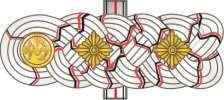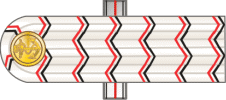The military ranks of the German Empire were the ranks used by the military of the German Empire. It inherited the various traditions and military ranks of its constituent states.
Ranks of the Imperial German Army
See also: Imperial German ArmyOfficer corps
Critics long believed that the Army's officer corps was heavily dominated by Junker aristocrats, so that commoners were shunted into low-prestige branches, such as the heavy artillery or supply. However, by the 1890s, the top ranks were opened to highly talented commoners.
The rank insignia of commissioned officers.
| Rank group | General / flag officers | Senior officers | Junior officers | |||||||||||||||||||||
|---|---|---|---|---|---|---|---|---|---|---|---|---|---|---|---|---|---|---|---|---|---|---|---|---|
| Epaulette | 
|

|

|

|

|

|

|

|

|

|

|

| ||||||||||||
| Generalfeldmarschall | Generaloberst mit dem Rang als Generalfeldmarschall | Generaloberst | General der Waffengattung | Generalleutnant | Generalmajor | Oberst | Oberstleutnant | Major | Hauptmann/ Rittmeister |
Oberleutnant | Leutnant | |||||||||||||
Warrant officers and officer cadets
- Cadet (Fahnenjunker, ranking between Sergeant and Vizefeldwebel) – served as cadets in the various military academies and schools. After graduation, they became a Fähnrich.
- Ensign (Fähnrich, ranking between Vize-Feldwebel and Feldwebel) A probationary officer waiting to become a 2nd Lieutenant (Leutnant).
- Deputy Officer (Offizierstellvertreter, ranking above Etatmäßiger Feldwebel) A warrant officer usually used as a brevet Leutnant or an acting platoon leader.
- Uncommissioned Lieutenant (Feldwebelleutnant, a permanent rank as a junior 2nd Lieutenant with Lieutenant's pay, but without an officer's commission.) Usually used for staff work at the company level. They wore an officer's dress sword (degen) rather than an NCO's dagger. Still a member of the NCO's Mess until 1917, when he became eligible for the Officer's Mess.
Non-commissioned officers / Unteroffiziere
| Rank group | Unteroffizier mit Portepee | Unteroffizier ohne Portepee | ||
|---|---|---|---|---|
| Collar | 
|

|

|

|
| Epaulette | ||||
| Title | Etatmäßiger feldwebel | Vizefeldwebel | Sergeant | Unteroffizier |
| Cavalry/ Artillery |
Etatmäßiger wachtmeister | Vizewachtmeister | ||
- Unteroffizier mit Portepee ("Non-Commissioned Officer with Sword Knot"). Senior NCOs with the right to wear a ceremonial lanyard tied to the hilt of their NCO service dagger.
- Etatmäßiger Feldwebel ("Budgetary Sergeant-Major") A senior feldwebel who was on the regimental payroll. Nicknamed der Spiess ("the Pike"), they were equivalent to a British Regimental Sergeant Major.
- Feldwebel ("Sergeant-Major") A company's senior NCO. They were equivalent to a British Company Sergeant Major or an American First Sergeant.
- Vizefeldwebel ("Assistant Sergeant-Major") A platoon's senior NCO. They are equivalent to a British Staff Sergeant.
- Unteroffizier ohne Portepee ("Non-Commissioned Officer without Sword Knot"). Junior NCOs who did not have the right to wear the sword knot.
- Sergeant A junior NCO who leads a squad.
- Unteroffizier ("Subordinate Officer") A junior NCO who assisted the Sergeant in leading a squad. They are equivalent to a British or American Corporal.
Enlisted (Mannschaften/Gemeine) ranks
| Rank group | Enlisted | ||||
|---|---|---|---|---|---|
| Collar | 
|
||||
| Epaulette | |||||
| Title | Kapitulant | Einjährig-freiwilliger | Obergefreiter | Gefreiter | Soldat |
| English designation | Capitulant | One-Year Volunteer Enlistee | Senior Lance Corporal | Lance Corporal | Private |
- Musketeer (Musketier, Prussian army infantry regiments), Infantryman (Infanterist, Bavarian army infantry regiments), Soldier (Soldatzüng, Saxon army infantry regiments), Gunner (Kanonier, foot artillery), Pioneer (Pionier, pioneer branch). Other unit-specific enlisted ranks were: Fusilier (Füsilier), Grenadier (Grenadier), Huntsman otherwise Light-Infantryman (Jäger), Dragoon (Dragoner), Hussar (Husar), Cuirassier (Kürassier), Uhlan (Ulan), Fusilier Guard (Garde-Füsilier), Grenadier Guard (Garde-Grenadier), Wehrmann (Landwehr), etc.
- Lance Corporal (Gefreiter); up until 1918 the only rank (with exception of Obergefreiter in the foot artillery) to which a conscripted soldier could be promoted. The rank was a deputy rank to the Corporal (Unteroffizier) rank.
- Senior Lance Corporal (Obergefreiter); established in the Prussian Army from 1846 to 1853, reestablished in 1859, then in foot artillery only, replacing the artillery Bombardier rank that had been introduced in 1730.
Additionally, the following voluntary enlistees were distinguished:
- One-Year Volunteer Enlistee (Einjährig-Freiwilliger): despite the name, one-year volunteers were actually conscripts who served a short-term form of active military service, open for enlistees up to the age of 25. Such enlisted soldiers were usually high school graduates (Matura, Abitur), who would opt to serve a one-year term rather than the regular two or three-year conscription term, with free selection of their chosen military service branch and unit, but throughout were obligated to equip and subsist themselves at entirely their own cost. In today's monetary value, this could at bare minimum cost some 10,000 euro, which purposely reserved this path open to sons from mostly affluent social class families wishing to pursue the Reserve-Officer path; it was the specific intention of Wilhelm II that such Reserve-Officer career path should only be open to members of so-called "officer-material" social classes. On absolving their primary recruit training, those aspiring to become Reserve-Officers would have to qualify and achieve suitability for promotion to the Gefreiter rank and then would continue to receive further specialized instruction until the end of their one-year term, usually attaining and leaving as surplus Corporals (überzählige Unteroffiziere) (Reservists), with the opportunity to advance further as reservists. Enlistees who did not aspire to officer grade would leave at the end of their one-year term as Gemeine (Ordinary soldier) enlisted rank (for example Musketier or Infanterist) and a six-year reserve duty obligation. Eligibility for this specific one-year path of military service was a privilege approved upon examining the enlistee's suitability and academic qualifications.
- Long-Term Volunteer Enlistee "Capitulant" (Kapitulant): enlisted soldiers who had already absolved their regular two or three-year military conscription term and had now volunteered to continue serving for further terms, minimum was 4 years, generally up to 12 years.
Note: Einjährig-Freiwilliger and Kapitulant were not ranks as such during this specific period of use, but voluntary military enlistee designations. They, however, wore a specific uniform distinction (twisted wool piping along their shoulder epaulette edging for Einjährig-Freiwilliger, the Kapitulant a narrow band across their lower shoulder epaulette) in the colours of their respective nation state. This distinction was never removed throughout their military service nor during any rank grade advancements.
Naval ranks and ratings
The Imperial German Navy's rank and rating system combined that of Prussia's with the navies of other northern states.
Commissioned officer ranks
The rank insignia of commissioned officers.
| Rank group | General / flag officers | Senior officers | Junior officers | |||||||||||||||||||||
|---|---|---|---|---|---|---|---|---|---|---|---|---|---|---|---|---|---|---|---|---|---|---|---|---|
| Epaulette | 
|

|

|

|

|

|

|

|

|

| ||||||||||||||
| Sleeve insignia |

|

|

|

|

|

|

|

|

|

| ||||||||||||||
| Großadmiral | Admiral | Vizeadmiral | Konteradmiral | Kapitän zur See/ Kommodore |
Fregattenkapitän | Korvettenkapitän | Kapitänleutnant | Oberleutnant zur See | Leutnant zur See | |||||||||||||||
Rank flags
| Title | Großadmiral | Admiral | Vizeadmiral | Konteradmiral |
|---|---|---|---|---|
| Command flag | 
|

|

|

|
Officer cadets
| Title | Oberfähnrich zur See | Fähnrich zur See | Seekadett |
| Epaulette | |||
| Sleeve | 
|

|

|
| English designation | Midshipman | Sea cadet | Junior sea cadet |
Warrant officers
| Warrant officers | |||
|---|---|---|---|
| Title | Deckoffiziere als Offizier-Stellvertreter |
Oberdeckoffizier | Deckoffizier |
| Shoulder | 
|

|

|
| English designation | Chief Warrant Officer as Acting Commissioned Officer. |
Chief Warrant Officer | Warrant Officer |
| Specialty designations | Offizier-Stellvertreter | Oberbootsmann Obersteuermann Oberfeuerwerker |
Bootsmann Steuermann Feuerwerker |
| English designation | Acting Commissioned Officer | Chief Boatswain Chief Helmsman Chief Artificer |
Boatswain Helmsman Artificer |
Petty officers
Seamen
| Seamen | |||
|---|---|---|---|
| Title | Obermatrose | Einjährig-Freiwilliger | Matrose |
| Sleeve | 
|

|
|
| English designation | Seaman 1st Class | Seaman Volunteer (i.e.: Reserve Officer Candidate) |
Seaman |
Notes
- Several German armies and national contingents, including Prussia and Bavaria, traditionally used two different captain ranks that originated with the ownership of units. The Captain 1st Class was either the proprietor who had raised and equipped the Company / Troop / Battery or was a gentleman or nobleman who had bought a commission as its nominal Captain. The Captain 2nd Class (or Stabshauptmann > "Staff Captain") was its actual commander. By the end of the 19th century that dual-system had been gradually phased out and replaced by a single rank.
- Duden; Origin and meaning of "Korporal", in German.
- Duden; Definition of "Gemeine", in German.
- Duden; Definition of "Kapitulant", in German.
References
- Ulrich Trumpener, "Junkers and Others: The Rise of Commoners in the Prussian Army, 1871–1914," Canadian Journal of History (1979) 14#1 pp 29–47
- Dennis E. Showalter, "The Political Soldiers of Bismarck's Germany: Myths and Realities," German Studies Review (1994) 17#1 pp. 59–77 in JSTOR
- Korporal
- ^ "Gefreiter" – Allgemeine Encyclopädie der Wissenschaften und Künste, Erste Section, A-G, (Universal Encyclopaedia of the Sciences and Arts, First Section, A-G), Author: Johann Samuel Ersch and Johann Gottfried Gruber, Publisher: F. A. Brockhaus, Leipzig, 1852, Page 471-472, in German.
- ^ Meyers Konversations-Lexikon, 4th Edition, Volume 6, Bibliographisches Institut, Leipzig 1885–1892, Page 659. in German
- Gemeine Buchstabe Soldat
- Meyers Konversations-Lexikon, 4th Edition, Volume 10, Bibliographisches Institut, Leipzig 1885–1892, Page 116, in German
- Kapitulant
- ^ "Dienstgrade und Uniformen." Kleinen Kreuzers “Dresden” (I). Retrieved 2017-09-22.
- Bunkley 1918, pp. 174–175.
- Williams 1918, p. 274.
Bibliography
- Bunkley, Joel William (1918). Military and Naval Recognition Book: A Handbook on the Organization, Uniforms and Insignia of Rank of the World's Armed Forces (2nd ed.). New York: D. Van Nostrand Company. Retrieved 29 June 2022.
- Williams, Dion (1918). "XI: Uniforms and Insignia of Foreign Armies and Navies". Army and Navy Uniforms and Insignia. New York, N.Y.: Frederick A. Stokes Company. pp. 216–292. Retrieved 5 July 2022.
Further reading
- Kraus, Jürgen (2006). The German Army in the First World War: Uniforms and Equipment, 1914 to 1918. Militaria Verlag. ISBN 978-3950164268.
- Somers, Johan (2004). Imperial German Field Uniforms And Equipment 1907-1918, Volume 2. Schiffer Publishing, Ltd. ISBN 978-0764322624.
- Somers, Johan (2007). Imperial German Field Uniforms And Equipment 1907-1918, Volume 3. Schiffer Military History. ISBN 978-0764327780.
- Woolley, Charles (1999). Uniforms & Equipment of the Imperial German Army 1900-1918. Schiffer Military History. ISBN 978-0764309359.
External links
- Die Uniformen der Deutschen Armee II (in German). Leipzig: Verlag von Moritz Ruhl. 1899. Retrieved 29 December 2022.
- Plates illustrating the New German field service uniform of the Prussian army. London: General Staff, War Office. 1916. Retrieved 14 October 2023.


